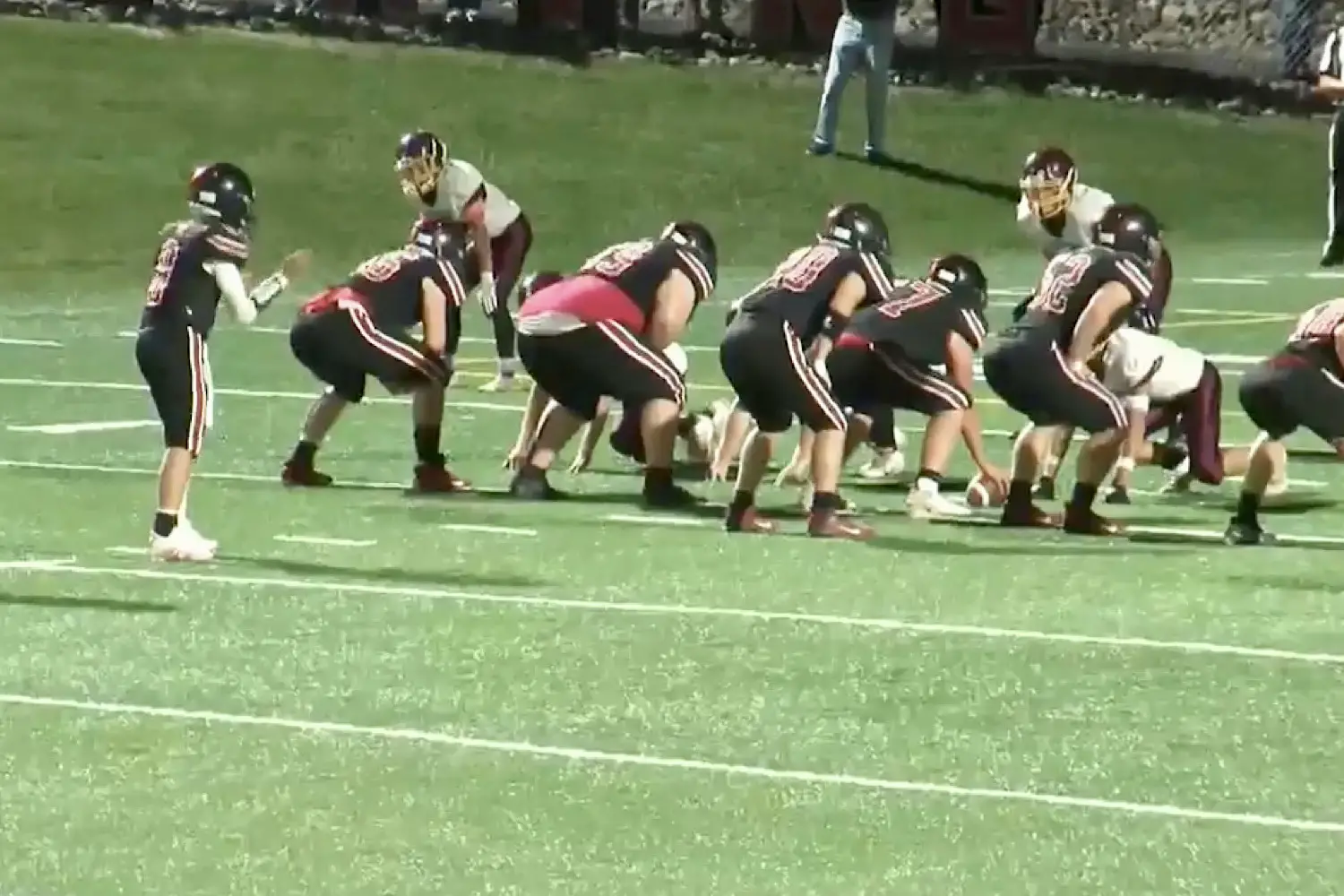
BROCKWAY, Pa. (EYT/D9) — Frank Varischetti had a problem.
One football. Multiple weapons.
Varischetti, the head football coach at Brockway in the late 2000s, mulled over the best way to utilize all the talent he had, especially at the quarterback position with a budding young star in Derek Buganza.
He thought outside the box.
(Pictured above, Brockway quarterback Brayden Fox is ready to receive a shotgun snap. Fox is the latest quarterback to put up big numbers in the Frank Varischetti spread offense/submitted photo)
A big fan of college football coaches like Mike Leach, Hal Mumme and Tony Franklin, Varischetti was intrigued by the cutting-edge offenses they had whipped up and unleashed on unsuspecting defenses.
It was a second-generation version of the run-and-shoot. Shotgun. Four wide receivers. One running back. No tight end.
No prisoners.
It came to be known as the “Air Raid” offense, and it swept through college football like a wildfire.
Varischetti brought its concepts to Brockway, and it changed the football landscape in District 9 forever.
“I think it was the first time that anybody that had good athletes attempted that,” Varischetti said. “If anybody had good skill guys before, they just handed them the ball. Well, we had four or five really skilled guys and a quarterback who could throw the ball, and we just thought that was the best way to spread the ball around. No one was doing what we wanted to do at the time.”
What made the scheme particularly vexing to defenses was the no-huddle, pedal-to-the-metal pace.
It wasn’t uncommon for those Brockway teams in the early stages of the attack to run 90 plays per game.
It was an unrelenting onslaught of quick passes, draw plays and some deep shots to speedy receivers. Defenses were gassed. Numbers changed on the scoreboard as quickly as a NASDAQ ticker.
“It was basketball on turf,” said former Brockway player under Varischetti and current Rover coach Jake Heigel.
“No one was playing with tempo back then,” Varischetti said. “It just seemed defenses didn’t know what to do because it just wasn’t done then. That’s why we did it.”
It produced video game numbers and loads of success for the Rovers.
In three seasons in the offense, Buganza amassed 9,252 passing yards and 91 touchdowns. He put the ball in the air a staggering 978 times, completing 603 of them.
In 2009, Brockway had two 1,000-yard wide receivers in juniors Mike Vervoort and Jake Shaffer.
In 2010, the Rovers scored 621 points, beat Brookville 50-0 in the district title game, routed District 8 champ Oliver in a state playoff matchup before losing to District 7 powerhouse South Fayette to finish 12-1.
“I don’t think anyone knew how to cover it, so we got really basic coverages,” Varischetti said. “We had a few really good plays against Cover 3, a few good plays versus man and that was basically what we saw. We did see some Cover 2 and we had some good home run threats against that. And the tempo on top of it. People just couldn’t get their calls in on time, so we were getting very, very basic looks.”
Varischetti was 30-16 in his four years at Brockway as his offense shredded defenses.

(Frank Varischetti during his time at DuBois)
Its tentacles soon reached every corner of the district.
Varischetti moved on to DuBois and brought that offense with him. The Beavers were 41-24 during his six-year tenure there and the attack made quarterback stars out of Sean Sleigh, Gabe French and Matt Miller.
But DuBois parted ways with Varischetti after the 2016 season. He took his offense to Brookville as the offensive coordinator and made a prolific passer out of Jack Krug, who threw for 8,362 yards and 108 touchdowns.
The offense spread to St. Marys with Varischetti as the OC, and then back to Brockway in 2021, where Brayden Fox has become the latest QB to put up eye-popping numbers. Fox has 5,179 passing yards and 56 touchdowns over the last two seasons.
Now, just about every high school program in D9 is running some elements of what Varischetti brought to the table some 15 years ago.
“It’s funny because when I got out of high school until just about the time I got back (in 2020 as the Brockway head football coach), that’s pretty much all you saw in District 9,” said Heigel, who went on to play at Clarion University after he graduated from DuBois Central Catholic in 2013. “Except for a few teams, there was a lot of spread concepts. Like everything, it’s cyclical. It was the hot, flashy new thing back in the day.”
Varischetti kept no secrets.
If another coach asked him about the philosophy of his attack, he told him. He shared the Xs and Os with anyone who wanted to learn.
That helped the offense system travel rapidly across the district.
Varischetti was flattered.
“It was pretty neat to see,” he said. “I mean, I would never really hide what we did. If anybody asked, I always told them exactly where we got things and how we did it. I might not have said exactly how, technique-wise, but the plays are the plays. It’s how you teach techniques that really makes the difference. I’ve also been very open with any coach that wants to know how we do stuff, and we’ve shared things with teams all over the district, all over the state, even with some out of state teams.”
These days, however, the pendulum may be swinging back.
With so many teams running spread concepts, the old fashioned, run-heavy, hard-nosed attacks are primed to bludgeon unsuspecting defenses again.
Three yards and a cloud of dust — well, in modern times, clouds of rubber pellets — is what few teams are prepared to stop.
THE GREMLIN WAY
The Karns City football program has been unaffected, it seems, by the passage of time.
As offenses have migrated from the ground to the air, from tight formations with quarterbacks under center to spread formations with QBs in the shotgun, the Gremlins have remained true to a blueprint that has endured for decades.
“I feel like we’re the abnormality of the league,” said Karns City coach Joe Sherwin. “We’re under center and most of the other teams are spread offenses. We huddle up, so we’re like the dinosaur. We’re like a dying breed.”
Sherwin played in the system. He’s coached in it, too. Some of the plays he ran when we was in pads have the same name and design as the ones that are in his playbook.
“It’s something we’ve done for a long time,” Sherwin said. “Certain plays guys have run for a long time. When we call this play, they know exactly what to do. At the same time, you have to be able to throw the ball well, too. At times you want to incorporate those spread things because they are good as well.”
Sherwin says the best way to describe the Karns City offense is “multiple.” But it is still based heavily on the run with the quarterback predominantly under center.

(Karns City fullback Luke Garing bulled his way to more than 1,000 yards in the Gremlins’ run-heavy attack in 2022/Holly Mead Photography)
That was once very common. Now, not so much.
“I don’t think we played anyone last year that was strictly under center,” Varischetti said. “It just doesn’t exist. Now the teams that are strictly under center have the advantage. People aren’t used to seeing a fullback or a linebacker taking on an iso block.”
Out of necessity, Karns City took the run-first approach to the ultimate extreme during a two-week stretch early last season.
It was run first — and second and third and fourth.
With quarterback Eric Booher nursing a hairline fracture at the base of the thumb on his throwing hand and his backup, Mason Martin, out with a broken finger, also on his throwing hand, Karns City didn’t have a quarterback who could attempt a pass.
Booher played with a cast on his right wrist and forearm. Opponents knew a pass was off the table.
Didn’t matter. The Gremlins ran the ball 110 times without putting the ball in the air in back-to-back wins over Ridgway and St. Marys.
It was a remarkable feat in a time of spread offenses and advanced passing concepts in high school.
Very old school won out.
“You got to do whatever you can to win. That’s the situation we had to deal with,” Sherwin said. “I think that was one of those more successful parts of our season and it kind of led us into the end of the season.”
Karns City is the exception, though, to the rule. Few programs stick so religiously to the same offensive philosophy for as long as the Gremlins have.
After all, with graduation losses yearly and talent on the roster constantly in flux, coaches have found they must be willing to adapt.
Or die.
CHANGING LANES
At about the same time Varischetti’s offense was revolutionizing D9 football, in Cherry Township, Butler County, at the bottom of a steep, slopping hill, the Moniteau High School football team was experimenting with its own innovation.
Up until the mid-2000s, the Warriors were the prototypical run-oriented team.
Then Tyler Armagost — and later, his younger brother, Kyle Armagost — prompted a sea change in thinking.
Moniteau went to more four-wide sets. Some shotgun. Quicker passes. Four verticals. And the Armagosts had some monster seasons at quarterback.
So did Tony Campbell, who caught 43 passes for 1,018 yards and 14 touchdowns in 2008.
Things, though, have changed markedly on the banks of Glade Dam Lake.
Now current Moniteau coach Bob Rottman is changing lanes again.
Going full throwback mode.
This season the Warriors will rip pages out of a playbook from the 1960s.
“If we gotta go to triple option this year — because that’s what we’re essentially gonna do — we’ll do it. We’ll go Air Force, Navy. Army. I don’t see us being an Air Raid team any time soon.”
That’s what the talent dictates.
An older than old-school offense at Elk County Catholic will also see a big change this season under a new coach.
For years under former coach Tony Gerg, the Crusaders ran a single-wing attack. That offense dates all the way back to Pop Warner in the early 1900s.
ECC ran it to great success, especially last year when the Crusaders went 8-2.
But with Tim Pearson taking over the program and a plethora of talent at the skill positions, the Crusaders are breaking ranks with Glenn Scobey “Pop” Warner.
“ECC is gonna look different than it’s looked over the last decade from an offensive standpoint,” Pearson said. “We’re no longer running the single-wing. One of the reasons is we have some really dynamic players in the backfield.
“I don’t have an offense where I say, ‘Hey, I’m definitely gonna run this,’” Pearson added. “We’re continually modifying it. I want to tweak it and make it a flexible offense to engage the players that we have.”
Keystone coach Todd Smith has shown adaptability in his three decades of coaching high school football in stops at Clarion-Limestone, Clarion and Butler.
“Especially at a small school, you have to do what works with what you have and what they do the best,” said Smith, who oversaw a dynamic offense in his two seasons at Butler as the OC before taking the head coaching job at Keystone last season and producing a devastating ground game. “I feel like we adapt well to the skill set of the players we have.”
The same could be said of Dave Eggleton at Central Clarion.
During his days as the head coach at Clarion-Limestone for the co-op that formed Central, his teams ran the wing-T. Now with the Wildcats, and with electric playmakers all around quarterback Jase Ferguson, his offensive philosophy has skewed toward the spread.
And toward run/pass option plays — all the rage now in the college and even the pros.

(Central Clarion quarterback Jase Ferguson has become dangerous with both his arm and his feet in a hybrid spread attack for the Wildcats that uses many run/pass option plays/file photo)
“I come from a wing-T background and we still incorporate a lot of the blocking schemes from a wing-T offense into our spread looks,” Eggleton said. “We’re adding more and more RPOs. Obviously, having a quarterback like Jase, he can handle those quick reads.
“Offense is way different now than it was even five years ago,” he added. “You didn’t see the RPOs like we see now. And you go back 10, 15 years, you didn’t see all that much shotgun. Now almost everyone is in a shotgun and spread.”
Ultimately, though, the kind of attack a team utilizes is moot unless the players are committed to executing it well.
“Regardless of the offense you run, in my opinion, if the kids buy into it and believe in it and put everything they have into it, they’ll be successful,” Rottman said.
THE NEXT BIG THING?
Things will never be like they were in the world high school football.
Offenses are constantly changing. Innovating. Finding ways to exploit defenses.
There will always be other Varischettis with their own innovative spin on offensive football.
It’s up to the defenses to change with the tide.
“The creativity of offensive coordinators has just evolved,” Heigel said. “It used to be everything drifted down from the NFL to college to high school. Now it almost feels like it’s drifting up. You see high schools running the spread, then colleges running the spread and you literally had the Cardinals running a straight-up, spread offense in the NFL.
“Honestly, it’s becoming quite a nightmare for defensive coordinators because of the creativity.”
The sheer number of different attacks is also a challenge.
A team can play an Air Raid offense one week, then square off against a wing-T the next.
“As a defensive coach, week in and week out, you can’t recycle anything,” said Redbank Valley coach Blane Gold. “Even if you have two wing-T teams back to back, they have their own flavor of it.”
Even Varischetti’s spread attack is not as effective as it once was.
“Defenses have definitely caught up,” he said. “It was a big advantage back then because we were the only team doing it. Everyone was lined up to face a wing-T team or an I-formation team every week and they get used to that and then, boom, all of a sudden you’re trying to defend 90 offensive plays out of a shotgun with footballs flying all over the place. Now that advantage is just gone.
“People are using wristbands defensively when they play us because it lets them get different calls into the game and everybody is on the same page very quickly. It’s just not the same advantage it used to be.”
What’s the next big thing?
No one knows.
“It’s going to be interesting to find out,” Varischetti said.












